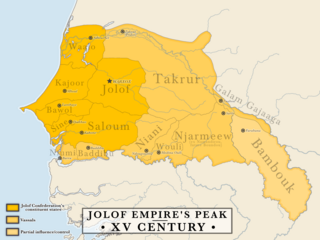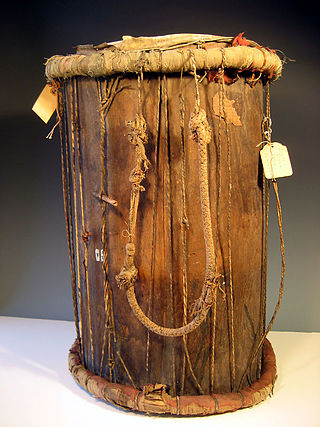
The Kingdom of Saloum was a Serer kingdom in present-day Senegal and parts of Gambia. The precolonial capital was the city of Kahone. Its history, geography and culture was intricately linked with the sister state, the Kingdom of Sine, and it was common to refer to them as the Sine-Saloum or the Serer Kingdoms.

The Jolof Empire, also known as Great Jolof, or the WolofEmpire, was a Wolof state that ruled parts of West Africa situated in modern-day Senegal, Mali, Gambia and Mauritania from around the 12th century to 1549. Following the 1549 battle of Danki, its vassal states were fully or de facto independent; in this period it is known as the Jolof Kingdom.

The Serer people are a West African ethnoreligious group. They are the third-largest ethnic group in Senegal, making up 15% of the Senegalese population. They also reside in northern Gambia and southern Mauritania.
Mamadu Diakhou Bâ, also known as Maba Jahou Bah, Ma Ba Diakhu, Ma Ba Diakho Ba, Ma Ba Jaaxu, Mabba Jaxu Ba, was a Muslim leader in West Africa during the 19th century. He was a disciple of the Tijaniyya Sufi brotherhood and became the Almami of Saloum.

The Kingdom of Sine was a post-classical Serer kingdom along the north bank of the Saloum River delta in modern Senegal.

The Saltigue, are Serer high priests and priestesses who preside over the religious ceremonies and affairs of the Serer people, such as the Xooy ceremony, the biggest event in the Serer religious calendar. They usually come from ancient Serer paternal families, and the title is inherited by birthright. In Serer country, Saltigue are always diviners.
Maad a Signig Kumba Ndoffene Famak Joof was the King of Sine in modern-day Senegal. Maad a Sinig means king of Sine. He ruled from 1853 until his death on 23 August 1871. He was the son of Maad Souka Ndela Joof and Lingeer Gnilane Jogoy Joof. His father – Maad Souka Ndela came from The Royal House of Semou Njekeh Joof founded by Maad Semou Njekeh Joof in the early 18th century, which was the third and last Royal House of Joof family of Sine and Saloum. His paternal family ruled three Kingdoms : Sine, Kingdom of Saloum and previously the Kingdom of Baol. They descended from Maad Ndaah Njemeh Joof the 13th century King of Lâ (Laah) in Baol.
Guelowar, also spelled Gelwar, Guelwar, Guelware, Gueleware or Gueloware, was a maternal dynasty in the pre-colonial Serer kingdoms of Sine and Saloum. They were from the Mandinka ethnic group. The offspring of Mandinka women and Serer men became the kings of Sine and Saloum. The dynasty lasted from the mid-14th century to 1969, the year both kings died.
Lamane or laman means "master of the land" in the Mandingue, Wolof, and Serer languages. The name was also sometimes the title of chiefs or kings of the Serer people of the Senegambia region which includes modern day Senegal and the Gambia. This title was also used by some kings of the Wolof kingdoms. The title is sometimes used interchangeably with the old title Maad. After the Guelowars' migration to the Sine and the foundation of the Kingdom of Sine, "lamane" denotes a provincial chief answerable to the King of Sine and Saloum.

The medieval history of the Serer people of Senegambia is partly characterised by resisting Islamization from perhaps the 11th century during the Almoravid movement, to the 19th century Marabout movement of Senegambia and continuation of the old Serer paternal dynasties.
Alioune Sarr was a Senegalese historian, author and politician whose family gained prominence in the Serer precolonial Kingdom of Sine and Saloum around the 14th century. They also made up the "sulbalƃe" class of Futa Toro. Sarr was born at Foundiougne. His father was a former Chief of Foundiougne, Gandoune, former head of the constituency of Ndiaye-Ndiaye and former prime minister of Diognick in Senegal. Although Sarr was a prominent politician like his father during the colonial era, he is best known as a historian and author especially after his famous work Histoire du Sine-Saloum which was officially published in 1949 and peer reviewed by historians.

Joof or Diouf is a surname that is typically Serer. This surname is also spelt Juuf or Juf.

Teigne was a Serer title for the monarchs of the pre-colonial Kingdom of Baol, now part of present-day Senegal. The Kingdoms of Baol and Cayor became intricately linked especially post 1549 when the Faal family came to into prominence, and it was the same family that eventually ruled both Kingdoms with the exception of few interruptions, notably Lat Joor Ngoneh Latir Jobe who was of a different patrilineage.
This is a timeline of the history and development of Serer religion and the Serer people of Senegal, The Gambia and Mauritania. This timeline merely gives an overview of their history, consisting of calibrated archaeological discoveries in Serer countries, Serer religion, politics, royalty, etc. Dates are given according to the Common Era. For a background to these events, see Roog, Serer religion, Serer creation myth, Serer prehistory, Lamane, States headed by Serer Lamanes, Serer history and Serer people.
Maad a Sinig Maysa Wali Jaxateh Manneh was a king described in the oral tradition of the Serer pre-colonial Kingdom of Sine and the first of the Guelowar maternal dynasty to rule in Serer country. He reigned as Maad a Sinig from c. 1350 to 1370.
The Royal House of Jogo Siga Joof was the second royal house founded by the Joof family during the Guelowar dynastic period of Sine. The Guelowar period commences from c. 1350 during the reign of Maad a Sinig Maysa Wali and ends in 1969 following the deaths of the last Serer kings of Sine and Saloum and the disestablishment of the monarchies in Serer countries. The pre-colonial Kingdom of Sine now lies within present-day Senegal.

Lingeer Fatim Beye Joos Fadiou was a 14th-century Serer princess and queen (Lingeer) from the Kingdom of Sine. She is the matriarch and early ancestor of the Joos Maternal Dynasty of Waalo. She is usually regarded by some sources as the founder of the Joos Maternal Dynasty. The pre-colonial Kingdoms of Sine and Waalo now lies within present-day Senegal. Her surname is Beye (English-Gambia) or Bèye (French-Senegal). Joos Fadiou is her maternal clan. In Serer, "Fa-tim" means "the maternal clan of..."
Babacar Sedikh Diouf or Babacar Sédikh Diouf is a Senegalese historian, author, researcher, campaigner against "Wolofization", a Pan-Africanist, and former teacher. He has written extensively about the history and culture of Senegal, Africa, and that of the Serer ethnic group to which he belongs. He usually writes by the pen name Babacar Sedikh Diouf.
The Soninke-Marabout Wars were a series of 19th-century civil wars across southern Senegambia pitting the traditional ruling classes of various states, mostly animist or only nominally Muslim, against Islamic reformers led by the marabout class. French and British forces frequently became involved in these conflicts, providing them an opportunity to extend colonial power into the hinterland.
Mbegane Ndour, also spelled Mbegaan Nduur, was the founder and first king of the Kingdom of Saloum in present-day Senegal.







